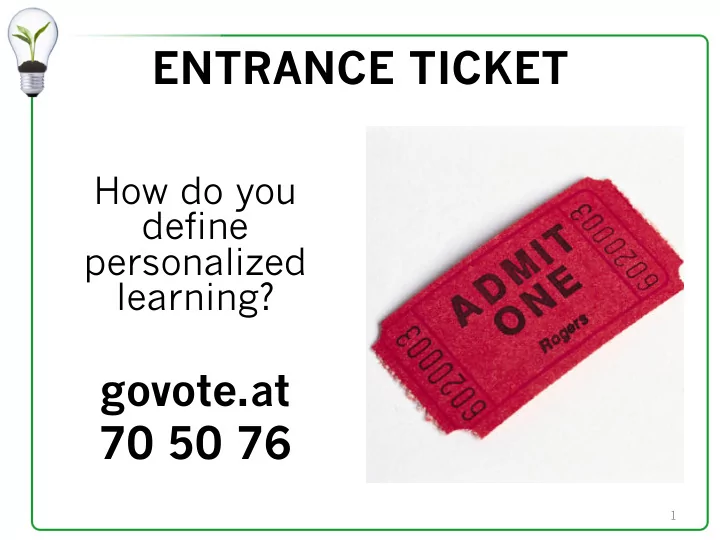

ENTRANCE TICKET How do you define personalized learning? govote.at 70 50 76 1
DEFINITION OF PERSONALIZED LEARNING “Personalized learning is a progressively student –driven model where students deeply engage in meaningful, authentic, and rigorous challenges to demonstrate desired outcomes.” — Zmuda, Curtis and Ullman (2015) 2
DEFINITION OF HABITS OF MIND Characteristics of what intelligent people do when they are confronted with problems, the resolutions to which are not immediately apparent. — Costa and Kallick (2008)
DISPOSITIONS: 16 HABITS • Persisting • Thinking and communicating with • Managing impulsivity clarity and precision • Listening with • Gathering data through understanding and all senses empathy • Creating, imagining, • Thinking flexibly innovating • Thinking about thinking • Responding with • Striving for accuracy wonderment and awe • Questioning and posing • Taking responsible risks problems • Thinking • Applying past knowledge interdependently to new situations • Remaining open to continuous learning
HOW THEY FIT TOGETHER If personalized learning is the organizational frame and pedagogical structure for learning, then explicit thinking behaviors are required: Habits of Mind.
PERSONALIZED LEARNING FILTERS 6
USE THE FILTERS TO EXAMINE A PRACTICE • Imagine a practice that you consider to be personalized learning. • Use the filters to answer the questions: – To what degree do you see the opportunity for student voice? – To what degree do you see the opportunity for co-creation? – To what degree do you see the opportunity for social construction? – To what degree do you see the opportunity for self-discovery? 7
DIFFERENTIATION AND INDIVIDUALIZATION 8
KEY DIFFERENCES INDIVIDUALIZATION DIFFERENTATION • Student controls the • Student selects from a pace of the topic as range of content, well as when to process, and/or demonstrate mastery. product options to meet the requirements. • Teacher drives instruction through • Teacher tailors teacher-created tasks instruction based on and related lesson individual student need plans. and preference. 9
POWER OF AUTHENTICITY TO ENGAGE LEARNERS ü Authentic problems, challenges, issues, ideas ü Authentic forms for performance ü Authentic audiences for presentation and refinement 10
11
“BE THE CHANGE” . 1. Become experts in a topic of their choice and identify issues related to that topic (empathy). 2. Look for greater understanding of issue by examining it from different perspectives and through the lens of a variety of disciplines (definition / integrated thinking). 3. Brainstorm ideas for solutions and evaluate each of the solutions for reasonableness and potential of success (ideation). 4. Select a solution to try and create a model (prototype). 5. Put idea / prototype out to others (colleagues, experts, stakeholders, etc.) for feedback (testing). 6. Using feedback, prototype and implementation plans are revised and then implemented. 12
IT’S PERSONAL You are deeply worried about _________ because the disease or condition runs in your family and is affecting a loved one. How do you get good information about: • seriousness of the disease or condition • preventive measures • healthy ways of coping • providing support to loved ones 13
VALUE ADDED Collaborate to develop and execute an idea that will contribute to the aesthetic beauty and health of a place or community. This development process includes: • survey of the area/neighborhood to determine current condition • interview people who use the space to find out their concerns and ideas • propose and get approval for the project • develop a plan of action and complete the task 14
TRANSITION TO PERSONALIZED LEARNING • 1 st Column: Key elements • 2 nd Column: Impact on role of the teacher and student • 3 rd Column: Habits of Mind developing a gradual release to more self-directed learning 15
GOALS What are the desired results? 16
INQUIRY AND IDEA GENERATION What sparks your thinking based on the topic? What is worth pursuing? 17
INSTRUCTIONAL PLAN What does designing a learning plan look like? 18
FEEDBACK How does feedback promote growth? 19
EVALUATION How is performance evaluated on a given task using criteria? 20
CUMULATIVE DEMONSTRATION OF LEARNING How do we show evidence of learning across time? 21
PERSONALIZED LEARNING FILTERS 22
USE THE FILTERS TO EXAMINE A PRACTICE • Imagine a practice that you consider to be personalized learning. • Use the filters to answer the questions: – To what degree do you see the opportunity for student voice? – To what degree do you see the opportunity for co-creation? – To what degree do you see the opportunity for social construction? – To what degree do you see the opportunity for self-discovery? 23
EXIT TICKET What are 1-2 burning questions that you need answered to help move PL forward? #csg2016 24
Recommend
More recommend